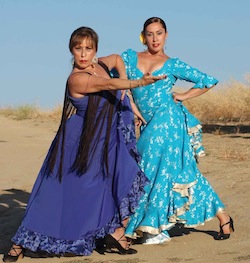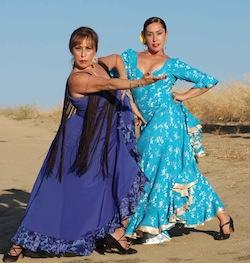
Ask a Bay Area critic or fan about the top flamenco performers around, and two names will surface pretty fast: Carolina Lugo and her daughter, Carolé Acuña. Their eponymous group, which Lugo founded in 1995, has grown into a hot spot for flamenco talent. For their latest run of shows, the duo will perform at three distinctive venues, from two large proscenium theaters to the cabaret-style Peña Pachamama. (There, to kick off the night’s Iberian journey, you might order a calimocho, that quintessentially Spanish mix of red wine and Coca-Cola.) Lugo and Acuña sat down for a quick phone interview before heading to the airport to pick up their guest artists from Spain, dancer Antonio Arrebola and singer Kina Mendez.
I’d like to know about your dynamic as mother and daughter. What does it bring to your practice?
Carolina Lugo: First of all, we know each other so well, we can predict what the other is going to do physically. We’ve done it for so long. Also, her style is more modern, while mine is more traditional. So sometimes I might say, “Give it more traditional form,” and she’ll sometimes tell me “Get it more modernized.” Sometimes there’s more — well, artists are temperamental, so there’s a little arguing! But it’s usually resolved in the studio, and it’s always resolved by the time we’re on stage.
Carolé, you’re the fifth generation of your family to dance. Was there ever any question you’d be a dancer, too?

Carolé Acuña: Yes, there was a question ... and I answered it! I just love to dance.
CL: I always knew her career was going to be in the arts. I never questioned it. I knew it was going to be her calling.
You’ve named your latest show Alas del Tiempo. Tell me about the title.
CL: Well, it means “Wings of Time” in Spanish. For us, wings represent the arms of a dancer and the lightness of arms in dance. There’s weightlessness, as in the majestic flow of a swan or an eagle, traveling through different points in time.
So the show does a little time-traveling?
CL: Yes! For the first half, “Leyenda/Asturias,” we’re dancing to a classical piece by Isaac Albéniz. Here the audience will see classical flamenco, truly Spanish ballet. The second half is more contemporary. Early on, though, we’re tying into classical flamenco the rhythms of samba, tango, Middle Eastern music.
Your shows will be at three rather different venues. Do the shows change correspondingly?
CL: Definitely. The floor show at Peña Pachamama is scaled down. It’s a tablao format, where the numbers are shorter, and not as theatrical. It’s very intimate. The audience can hear us breathing, see us perspiring.
CA: With tablao, there’s a certain standard you follow that doesn’t require months to prepare for. Also, you’re using fewer musicians in a tablao setting than you would in the theater.
For us, wings represent the arms of a dancer and the lightness of arms in dance. – Carolina Lugo
CL: And there’s more grandeur in a formal theater setting. Tablao is a more relaxed setting for the artist. But it’s very important, if you’re pursuing a career in flamenco as a dancer or a musician, that you train in tablao and tablao venues. It helps you prepare for the bigger concert venues that you’ll get ... hopefully!
Carolina, do you think flamenco has changed since you started dancing? If so, how?
CL: Oh, definitely. It changes every day: the costumes, the style of the hair, the way the flowers are arranged, the length of the dresses. When I was touring in the 1970s with the Lola Montes company, the styles were mid-calf — now they’re well past mid-calf, below the ankle bone. You can barely see your feet! Dresses were fuller then. Now, it’s more streamlined. They’re calling it “mermaid-style” cut — it hugs your body more. More women are wearing pants doing flamenco!
So has flamenco technique changed, too?
Too many women in the U.S. and Spain are losing sight of their femininity as flamenco dancers. – Lugo
CL: Yes. Some women, all they do is footwork now. It’s not me, but that’s their style. I would like a woman to be complete, for her to do everything: to use props, the shawl, the fan, castanets. Some of those artistic elements are getting lost. In my opinion, too many women in the U.S. and Spain are losing sight of their femininity as flamenco dancers.
CA: Today, it’s a lot more experimental. We’ve even got minimalist flamenco right now. There’s so many things you could imagine. People say, “I don’t have to do that just because I’m a man or a woman.”
CL: Some men are wearing batas de cola [traditional dresses]!
But that’s not for you two, correct?
CA: I like it, my mom doesn’t.
CL: Hey, don’t paint me as the fuddy-duddy! I like that stuff, too. But overall, yes, I am the traditionalist, because that’s how I was trained. If I try to be too modern, I’ll get criticized, and I’ll look “off.”
CA: This is how we argue!
CL: Overall, I’m a traditionalist and Carolé is a modernist. Where applicable.

